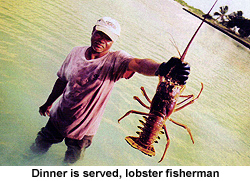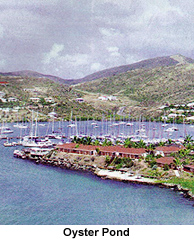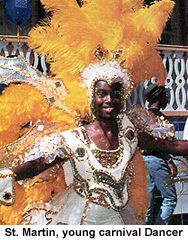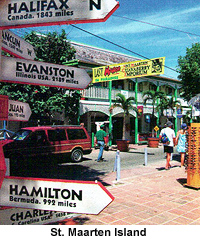| The British Virgin Islands consists of 60 enchanted islands adrift on the stunning turquoise sea. From sandy cays to towering volcanic peaks, to coral reefs formed over centuries, the British Virgin Islands beguile visitors with their secret harbors, pristine beaches, lush vegetation and friendly people. 
Europeans, Africans and Indians have all played a part in the history of these islands, leaving their mark on the diverse cultural tapestry. Today each island is a world unto itself. Lodge at a beachside cottage or luxurious villa, an international hotel or a resort that's the last word in understated elegance. Snorkel with exotic fish on coral reefs. Scuba dive to the wrecks of sunken galleons. Relax in the unspoiled beauty of national parks and botanic gardens. Or simply spend the day on a deserted beach.
Anguilla can be found just 150 miles east of Puerto Rico and nine miles north of St. Martin. The most northerly of the Leeward Islands in the Eastern Caribbean, Anguilla has a flat landscape and some of the finest beaches in the Caribbean. The tiny island is just 35 square miles, 16 miles long by three miles wide at its widest point. Anguilla is known for its stunning natural beauty, secluded beaches and exquisite resorts. Twelve miles of absolutely flawless white sand and coral beaches bordered by the Caribbean Sea and the Atlantic Ocean grace Anguilla's coastline. Committed to achieving environmental sustainability, the island protects its natural beauty and resources by caring for its beaches, dunes, reefs, shorelines and coastal waters. Constant trade winds, coupled with an average temperature of 80 degrees and low humidity keep the beaches comfortable year-round. Some of the island's best beaches include Shoal Bay West, Maundays Bay, Cove Bay and Merrywing Bay.
 The dual island destination of St. Martin/St. Maarten is definitely one of the most unique places to visit in the Caribbean. Boasting a French side and a Dutch side, the island is home to some of the best beaches and dining experiences in all of the Caribbean. The true beauty of St. Maarten lies in its easy mixing of cultures and freewheeling spirit that is often missing from other Caribbean islands. English, French, Dutch, Spanish and more intermingle here. Visitors can feel comfortable drinking beer on the street, sunbathing topless, or gambling until the wee hours. In fact, from a cultural standpoint St. Maarten owes more to Amsterdam's open policy than it does to its island neighbors.
The dual island destination of St. Martin/St. Maarten is definitely one of the most unique places to visit in the Caribbean. Boasting a French side and a Dutch side, the island is home to some of the best beaches and dining experiences in all of the Caribbean. The true beauty of St. Maarten lies in its easy mixing of cultures and freewheeling spirit that is often missing from other Caribbean islands. English, French, Dutch, Spanish and more intermingle here. Visitors can feel comfortable drinking beer on the street, sunbathing topless, or gambling until the wee hours. In fact, from a cultural standpoint St. Maarten owes more to Amsterdam's open policy than it does to its island neighbors.
As the only completely duty-free island in the Caribbean, St. Maarten offers some of the best shopping in the islands. Specialty items in the capital, Philipsburg, include Swiss watches, French perfume, British cashmeres, Chinese embroidery, Japanese electronics, Italian leather goods and more. Phillipsburg's Front Street and Back Street provide long stretches of amazing deals that are sure to grab your attention.
The French side of the island maintains its own unique identity. Diversity is a part of the daily fare at the Marigot seafront market: tropical fruits, spices, punches, fish, lobsters, handicrafts, souvenirs, and a mixture of odors and colors. Fine cuisine remains the flagship of St. Martin's culture. At the hands of great chefs the island's dining options have been reinvented to reflect the island's hybrid nature.  The St. Martin of days gone by, with its traditional and colorful huts, has transformed itself over the centuries into the gastronomic capital of the Caribbean, offering charming bistros and fine restaurants. Orient Bay owes its fame to its beachside restaurants, a meeting place for the jet set and show business personalities, without the glitter or paparazzi. The St. Martin of days gone by, with its traditional and colorful huts, has transformed itself over the centuries into the gastronomic capital of the Caribbean, offering charming bistros and fine restaurants. Orient Bay owes its fame to its beachside restaurants, a meeting place for the jet set and show business personalities, without the glitter or paparazzi.
The two islands that make up the Federation of St. Kitts & Nevis are situated in the, roughly 1,200 miles from Miami. St. Kitts, the larger of the two, is 68 square miles with a population of just over 35,000. The island is a place of tremendous history. Its location made it an important gateway into the Caribbean and as such has seen its fair share of power struggles. Today, the peaceful calm that resides over the island belies its turbulent past.
Because its coasts lie on both the Atlantic and the Caribbean Sea, St. Kitts has several types of beaches. The southern part of the island boasts honey brown beaches such as Frigate Bay, White House Bay, and Sand Bank Bay while the northern part of the island has black volcanic sand beaches like Dieppe Bay. The eastern coast experiences heavy Atlantic surf and the western coast has the Caribbean's calm, blue waters.
The tiny island of St. Eustatius, affectionately called Statia, is situated in the northwest Caribbean just 20 minutes from St. Maarten and just a few hours from many major US cities. Statia offers visitors a variety of natural attractions and activities including diving, hiking  and sunbathing while the small number of hotels allows for complete peace and quiet. The island enjoys a climate that is generally dry and sunny. Light northeast tradewinds bring constant cool breezes and sufficient moisture to keep daytime temperatures from getting too warm. So anytime of year is a great time to visit. and sunbathing while the small number of hotels allows for complete peace and quiet. The island enjoys a climate that is generally dry and sunny. Light northeast tradewinds bring constant cool breezes and sufficient moisture to keep daytime temperatures from getting too warm. So anytime of year is a great time to visit.
Diving is a major part of Statia's tourism draw. The warm water and underwater volcanic fissures and canyons have given the area a diversified diving selection. Divers can discover coral and sponge covered walls and pinnacles with dramatic backdrops of visual delights. One of the many dive sites in Statia consists of tangled shipwrecks located in 60 to 70 ft. of water. Many of these wrecks are surrounded by hundreds of schooling snappers, goat fish and others. For those interested in archeological dives, Statia has its fair share.
The islands of Antigua & Barbuda are located roughly 17 degrees north of the equator. The expansive winding coastline provides a wealth of secluded, powdery soft beaches. The exquisite coral reefs attract visitors from around the world while the quiet island of Barbuda is home to one of the region's most significant bird sanctuaries. There are 365 beaches on Antigua, one for every day of the year. The majority of the island's beaches rest inside the calm, protected waters of the island's Caribbean side. All are open to the public, and so the challenge for a visitor is to locate the beach that suits one's individual tastes.
When traveling to any of these destinations, be sure to have your passport ready. While the US dollar is still widely accepted, be certain you know the exchange rates. Many of the smaller islands use EC dollars, making it very easy to use one currency on an assortment of islands.
WHO YOU GONNA CALL?
Antigua & Barbuda Tourist Office - (888) 268-4227
www.antigua-barbuda.org
St. Eustatius Tourism Development Foundation - 001-713-622-8000
www.statiatourism.com
St. Kitts Tourism Authority - (800) 582-6208
www.stkittstourism.kn
Nevis Tourism Authority - (866) 55 - NEVIS
www.nevisisland.com
The Anguilla Tourist Board - (800) 553-4939
www.anguilla-vacation.com
The British Virgin Islands Tourist Board - (800) 835-8530
www.bvitourism.com
St. Maarten Tourist Office - (212) 953-2084
www.st-maarten.com
St. Martin Tourist Office - (877) 956-1234
www.st-martin.org
|